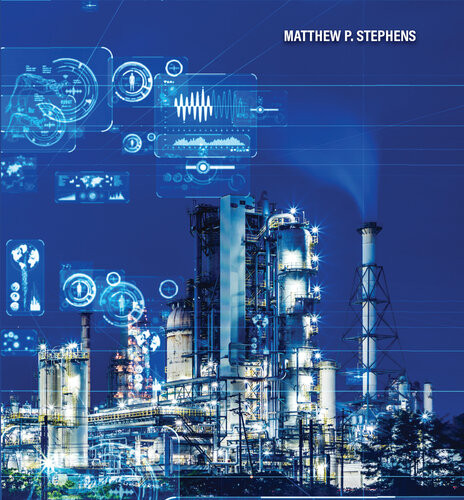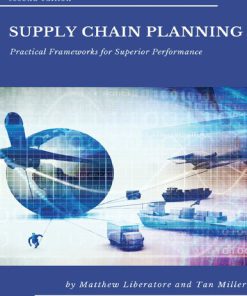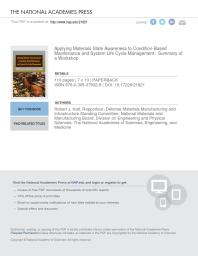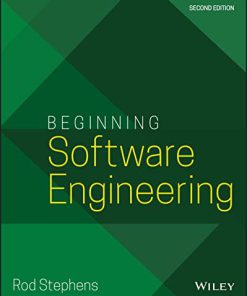Productivity and Reliability Based Maintenance Management 2nd Edition by Matthew Stephens 1612497497 9781612497495
$50.00 Original price was: $50.00.$25.00Current price is: $25.00.
Productivity and Reliability Based Maintenance Management 2nd Edition by Matthew Stephens – Ebook PDF Instant Download/Delivery: 1612497497, 9781612497495
Full download Productivity and Reliability Based Maintenance Management 2nd Edition after payment

Product details:
ISBN 10: 1612497497
ISBN 13: 9781612497495
Author: Matthew P. Stephens
Productivity and Reliability-Based Maintenance Management, Second Edition is intended to provide a strong yet practical foundation for understanding the concepts and practices of total productive maintenance (TPM) management—a proactive asset and resource management strategy that is based on enhancing equipment reliability and overall enterprise productivity. The book is intended to serve as a fundamental yet comprehensive educational and practical guide for departing from the wait-failure-emergency repair cycle that has plagued too many industries, instead advancing a proactive and productive maintenance strategy. It is not intended to be a how-to-fix-it manual, but rather emphasizes the concept of a world-class maintenance management philosophy to avoid the failure in the first place. Universities, junior and community colleges, and technical institutes as well as professional, corporate, and industrial training programs can benefit by incorporating these fundamental concepts in their technical and managerial curricula. The book can serve as a powerful educational tool for students as well as for maintenance professionals and managers.
In addition to updating the previous historical and statistical data and tables, the second edition expands on and adds to case studies based on current maintenance-related events. Several numerical examples and explanations are revised in order to enhance the clarity of the methodology. The second edition introduces the readers to the state-of-the-art concepts of the Internet of Things (IoT), smart sensors, and their application to maintenance and TPM.
Productivity and Reliability Based Maintenance Management 2nd Table of contents:
1 Introduction
1.1 Introduction to Maintenance Management
1.1.1 Definition of Maintenance
1.2 Maintenance Objectives
1.2.1 Primary Goals
1.2.2 Secondary Goals
1.3 Management and Structure of the Maintenance Function
1.3.1 Planning
1.3.2 Scheduling
1.4 Total Productive Maintenance (TPM)
1.4.1 Definition
1.4.2 Operator Responsibility
1.4.3 Obstacles to Achieving Full Equipment Effectiveness
1.5 Types of Maintenance Activities
1.5.1 Reactive or Corrective Maintenance
1.5.2 Preventive Maintenance (PM)
1.5.3 Predictive Maintenance (PDM)
1.6 Maintenance Department Organization
1.6.1 Centralized Maintenance Department
1.6.2 Decentralized Maintenance Organizations
1.6.3 Combined System
1.7 Maintenance in Service Industries
Case in Point: The Crash of Flight 261
Case in Point: The Collapse of the Condominium in Florida
1.8 Changing Maintenance Strategies
2 Statistical Applications
2.1 Reliability
2.2 System Reliability
2.2.1 Series Systems
2.3 Failure Rate
2.3.1 Determining the Failure Rate
2.4 Mean Time Between Failures, Availability, and Mean Downtime
2.4.1 MTBF Defined
2.4.2 Calculating MTBF
2.5 Improving System Reliability
2.5.1 Parallel Systems
2.5.2 Combinations of Series and Parallel Systems
2.5.3 Comparative Analysis of Series and Parallel Systems
2.6 Equipment Life Cycle Failure Rate
2.6.1 Infant Mortality
2.6.2 Chance Failure
2.6.3 Wear-Out Phase
2.7 Exponential Probability Distribution
2.7.1 Weibull Distribution
2.8 Graphical Analysis
2.8.1 Obtaining Reliability Data from a Graph
2.8.2 Determining the Desired PM Interval from a Graph
2.9 Mathematical Analysis
2.9.1 Failure Rate Equation
2.9.2 Reliability at Time (t)Equation
2.9.3 Economics of Acceptable Risk Levels Case in Point: A Reliability Study for a Diesel Engine
2.10 Queuing Theory and Applications
2.10.1 Queuing Models
2.10.2 Basic Queuing Model Calculations
3 Preventive Maintenance
3.1 Preventive Maintenance
3.1.1 Routine Preventive Maintenance
3.1.2 Major Preventive Maintenance
3.2 Equipment History
3.2.1 Establishing and Updating History
3.2.2 Determining Reliability, MTBF, and Availability
3.3 Establishing a System of Criticality
3.3.1 Three Degrees of Equipment Criticality
3.4 Planning for Preventive Maintenance
3.5 Design for Maintainability
3.6 Cost of Preventive Maintenance
Case in Point: The Plight of ComEd
4 Predictive Maintenance
4.1 Introduction
4.1.1 Definition of Predictive Maintenance
4.1.2 PDM’s Reliance on Science and Technology
4.1.3 Decision Factors Regarding PDM
4.1.4 PDM’s Quantitative Nature
4.1.5 Approaches to Data Collection
4.1.6 Data Analysis
4.2 Predictive Maintenance Techniques
4.2.1 Vibration Analysis
Case in Point: Vibration Monitoring Averts Plant Failure
4.2.2 Chemical Analysis
4.2.3 Tribology
4.2.4 Thermography
4.2.5 Ultrasound Techniques
4.3 TPM and Advanced Technologies
4.3.1 Data and Machine Learning
4.3.2 TPM in the Era of Industry 4.0
5 Nondestructive Testing and Evaluation
5.1 Introduction
5.2 Eddy Current Testing Case in Point: The Inspection of Pressurized Water Reactors
5.3 Radiography
5.3.1 Radioscopy
5.3.2 Neutron Radiography
5.3.3 Tomography
5.3.4 Magnetic Resonance Imaging
5.3.5 Quantitative Radiography
5.4 Liquid Penetrant Testing
5.5 Magnetic Particle Testing
5.5.1 Magnetic Particle Classification
5.6 Holography
6 Implementing TPM
6.1 Total Productive Maintenance
6.1.1 Successful Implementation of TPM
6.2 A Change in the Corporate Culture
6.2.1 Deming’s Legacy
6.3 Unions and TPM
6.4 The TPM Journey
6.4.1 Introducing and Promoting TPM
6.4.2 Communicating the Goals and Objectives of TPM
6.4.3 Assessing Current Conditions
6.4.4 Assessing Current Maintenance Effectiveness
6.5 Overall Equipment Effectiveness
6.5.1 Availability
6.5.2 Efficiency
6.5.3 Quality
6.6 TPM Activities and Processes
6.6.1 Cleaning
6.6.2 Developing Lubrication Standards
6.6.3 Inspection
6.6.4 Workstation Organization
6.6.5 Continuous Process Improvement
7 TPM Implementation and Process Improvement Tools
7.1 Introduction
7.2 Benchmarking
7.2.1 A Blueprint for Benchmarking
7.3 The Five Pillars of TPM
7.3.1 TPM Principles
7.4 The Eight Pillars of Maintenance
7.5 Failure Mode and Effect Analysis
7.5.1 FMEA Categories
7.5.2 Performing a Service FMEA 181 Case in Point: A Shocking FMEA
7.6 Root Cause Analysis
7.6.1 The Process of Root Cause Analysis
7.6.2 Techniques for Root Cause Analysis
7.6.3 Ishikawa Diagram
7.7 Fault Tree Analysis
7.8 Implementing a Solution
7.8.1 Alternative Solutions
7.8.2 Evaluating Alternative Solutions
Case in Point: A Chain Is Only as Strong as Its Weakest Link
8 Facility Maintenance Projects Planning and Control
8.1 Facility Maintenance Projects
8.1.1 Definition of a Maintenance Project
8.1.2 Successful Project Management
8.2 The Role of the Project Manager
8.2.1 The Project Manager’s Responsibilities
8.3 Maintenance Operations Analysis
8.3.1 Maintenance Operations Procedures
8.3.2 Regular Maintenance Tasks Identified
8.3.3 Implementing Specific Maintenance Activities
8.3.4 Scheduling Work Items
8.3.5 Time Estimates
8.3.6 High-Level Estimates
8.4 Project Management Tools and Techniques
8.4.1 Basics of the CPM and PERT Networks
8.4.2 PERT Network Probability Analysis
8.4.3 CPM/Crash Analysis
8.4.4 A Realistic (Complex) PERT Project Example
8.5 Computer Program Solutions
8.5.1 Activity-on-Node Network Diagram Convention
8.5.2 More Computer Printout Examples
8.5.3 Manual Forward/Backward Pass Procedures on Activity-on-Node Diagrams
9 Computerized Maintenance Management Systems
9.1 Introduction
9.2 Basic Functions
9.2.1 Labor Tracking
9.2.2 Vendor and Manufacturer Information
9.2.3 Inventory Management
9.2.4 Equipment Records
9.2.5 Scheduling
9.2.6 Predictive Maintenance
9.2.7 Work Orders
9.2.8 Purchase Orders
9.2.9 Security
9.2.10 Reports
People also search for Productivity and Reliability Based Maintenance Management 2nd:
7-2 project two iot and ai in organizations
project management 2nd edition by adrienne watt
project management 2nd edition
jmp reliability analysis
Tags:
Matthew Stephens,Productivity,Reliability,Maintenance
You may also like…
Business & Economics - Management & Leadership
Financial Management for Health System Pharmacists 2nd Edition Robert P. Granko
Business & Economics - Logistics
Engineering - Energy & Power Resources
Computers - Applications & Software
Biology and other natural sciences - Plants: Agriculture and Forestry
Hi-Tech Farming for Enhancing Horticulture Productivity 1st Edition P. Parvatha Reddy
Business & Economics - Management & Leadership
Medicine - Diabetes
Management of Diabetic Foot Complications 2nd Edition Clifford P. Shearman (Editor)











